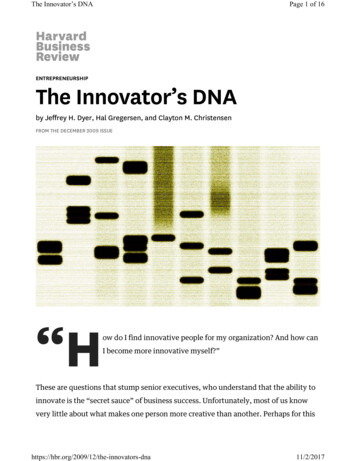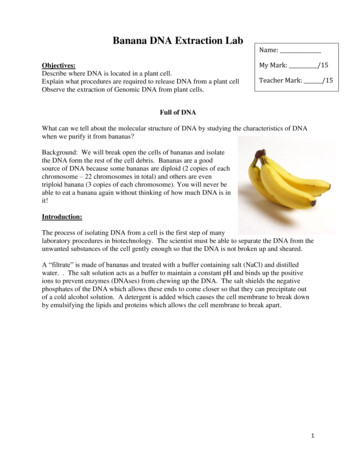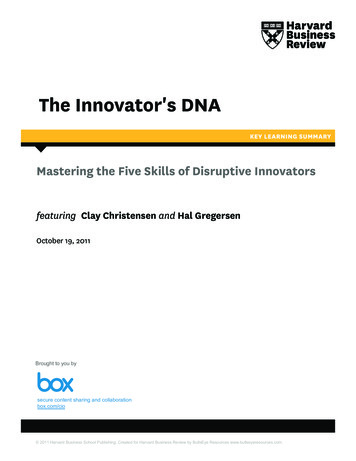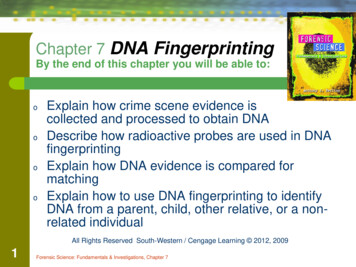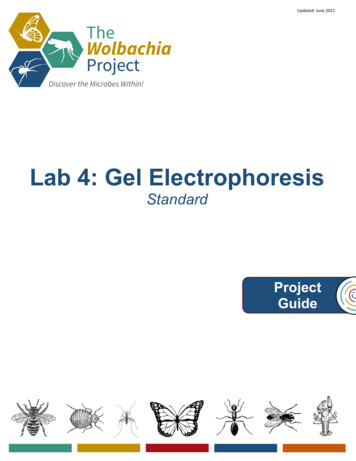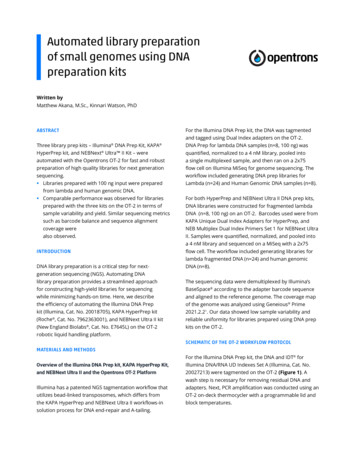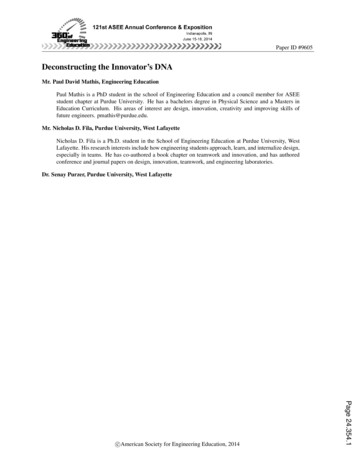
Transcription
Paper ID #9605Deconstructing the Innovator’s DNAMr. Paul David Mathis, Engineering EducationPaul Mathis is a PhD student in the school of Engineering Education and a council member for ASEEstudent chapter at Purdue University. He has a bachelors degree in Physical Science and a Masters inEducation Curriculum. His areas of interest are design, innovation, creativity and improving skills offuture engineers. pmathis@purdue.edu.Mr. Nicholas D. Fila, Purdue University, West LafayetteNicholas D. Fila is a Ph.D. student in the School of Engineering Education at Purdue University, WestLafayette. His research interests include how engineering students approach, learn, and internalize design,especially in teams. He has co-authored a book chapter on teamwork and innovation, and has authoredconference and journal papers on design, innovation, teamwork, and engineering laboratories.Dr. Senay Purzer, Purdue University, West LafayettePage 24.354.1c American Society for Engineering Education, 2014
Decoding the Innovator’s DNAAbstractInnovation plays a key role in transforming companies and markets. Engineers can contribute tothis transformation by developing skills to innovate. The Innovator’s DNA discusses the fivemajor innovation skills used by experts1. A better understanding of innovative skills of expertsand what sequence they were used may inform the education of future engineering students tohelp improve the development of their own innovative skills. This study used content analysison innovation case studies from three different literature sources. From these three books 53 casestudies were identified and coded based on the expert participants responses. Overall 67% of theexperts used observation when coming up with their innovative product of process. Questioningwas at 43% as the second most frequently used skill. Experimenting was used at the final stagesof innovation 91% of the time. The majority of experts started with observation leading intoquestioning and finished with experimenting. This suggests that engineering students mayimprove their ability to innovate if they develop their skills in observation, questioning, andexperimenting.IntroductionEngineering helps drive innovation through the development of products, processes, andentrepreneurship opportunities2. These products are usually found desirable by consumers andtheir sales help provide jobs and commerce. Many companies, such as Apple, General Electric,and Samsung, use innovation to transform and create markets that provide financial benefits bothnationally, and globally. Consensus in the field of engineering has focused on developing andpreparing future engineers with the proper knowledge, skills, and tools necessary for them tosucceed.The five skills, embodied in The Innovator’s DNA include association, experimenting,networking, observing, and questioning1. In the paper “Defining and Measuring InnovativeThinking Among Engineering Under-graduates” Amelink discussed recent literature that coversinnovative thinking skills that can be learned, such as observation of processes and questioning3.While, the Innovator’s DNA describes how these skills are used and contribute to innovativeideas, it does not explain which of these skills are more important or how these behaviors arelinked.Page 24.354.2The purpose of this study is to develop a better understanding of the five innovative skillsthrough a content analysis of expert innovators. More specifically we answered the followingquestions: a) Which of the five skills do innovators most frequently use first in their innovationprocess?; b) With which of the five skills do innovators most often conclude the innovationprocess?; c) Which sequence of skills do innovators most frequently use?; d) Which skills arecentral to innovation?
Research FrameworkUsing the Innovator’s DNA as a framework, this study identifies the sequences of skills used bysuccessful innovators. The skills in question are observation, questioning, experimenting,association, and networking. These skills are defined in The Innovator’s DNA as follows:1. Associating is the ability to make connections with things from different areas ofexpertise, knowledge, or location.2. Questioning is the ability to ask thought provoking questions on who, what, when, why,and push the questioning towards being a creative catalyst for the other skills.3. Observing is seeing the world around them, the people living there, and noticing bothwhat does and does not work in these situations.4. Networking is the ability to link ideas and opportunities with others that work and play inthe same or different areas of expertise then yours.5. Experimenting is the act of trying out new ideas or processes in search of new data thatmay lead to an innovative opportunity.The Innovator’s DNA directs its focus at the five major innovation skills used by experts but doesnot explain which of these skills are more important and how these behaviors are linked to eachother. We are looking to fill those gaps related to these five skills. The purpose of this paper is todevelop a better understanding on innovative skills through a content analysis of experts andexamine the possibilities of further study in applying it to teaching future engineering students.“One’s ability to generate innovative ideas is not merely a function of the mind, but alsoa function of behaviors. This is good news for us all because it means that if we changeour behaviors, we can improve our creative impact” 1.MethodsWe conducted a quantitative content analysis in order to identify the skills used most frequentlyduring the innovation process4. Content analysis is empirically grounded approach used toanalyze large amounts of text5. This research approach allowed us to explore an extensiveamount of data from a variety of published sources. Thus we were able to efficiently compile abroad database of examples of the use of discovery skills during the innovation process that weresufficiently-detailed for this study. While, the analysis is limited to published text rather thaninterviews with experts, this approach allowed us to analyze of a larger number of innovatorsfrom all over the world, an approach that would have been too costly to do.Page 24.354.3
Data SourcesWe established our criteria for identifying potential cases and reviewed related books. Theselection chosen for analysis were based on four criteria. First, the book must have been listedamong the 100 best-selling books in multiple innovation related fields (such as technologicalinnovations and creativity & genius) from two major book retailers6,7. Second, the book musthave received at least 50 citations according to Google Scholar8. Third, the book must be held byat least 500 libraries according to the WorldCat resource9. Finally, the books must havecontained detailed descriptions of expert innovators and their innovation projects. Based on thesecriteria, three books were selected for inclusion: The Innovator’s DNA1, The Medici Effect10, andThe Ten Faces of Innovation11. Table 1 displays these books’ performance on these criteria.Innovation cases were identified from the written text. To be selected for analysis, cases musthave been sufficiently detailed, describe an innovation, and the process the innovator used todevelop that innovation. This step was necessary to ensure that we could code for the discoveryskills employed during the innovation process. We identified and recorded 53 innovation casesfor analysis. These individual cases are listed in the appendix.Table 1. Ranking and References of BooksTimes cited in Google ScholarThe Innovator’sDNA139The MediciEffect339The Ten Facesof 4-(including 81 referencesto abridged journal paper)Library holdings (according toWorldCat)Sales rank: organizational change(Amazon.com)Sales rank: system and planning(Amazon.com)Sales rank: creativity and Genius(Amazon.com)Sales rank: Technology(Amazon.com)Sales rank: decision-making &problem (Amazon.com)Sales rank: Social & CulturalAspects of Technology (BN.com)Sales rank: TechnologicalInnovations & Transference(BN.com)Page 24.354.4
Data AnalysisTwo researchers coded each of the 53 examples based on a fixed coding protocol. These expertinnovator examples are listed in the appendix. The coding protocol included specific examplesrelated to the five innovator’s DNA skills: observation, questioning, experimenting, networking,and association1. The researchers coded a discovery whenever the text used a word or phrase thatdescribed an action related to the skill (See Table 2). For example, the text on page 90 of TheInnovator’s DNA, “He noticed a lower-middle class man riding a scooter with an older childstanding in front, behind the handle bars,” was coded as observation.Table 2. Coding ProtocolSkillsExamplesBook ExamplesAssociationConnecting, Creativity, Crosspollinate, CombiningMarc Benioff came up with the idea forsalesforce.com “It’s basically enterprise softwaremeets Amazon.”1. (pg. 42)ExperimentingMaking, Prototyping, Creating,DevelopingJeff Bezos saw the Internet could be ideal foroffering a catalog on books and felt he had enoughdata to run the experiment to see if books could besold over the internet1. ( pg. 135)ObservationWatching, Seeing, Noticing,ObservingRatan Tata noticed a lower-middle-class man ridinga scooter with his wife and two other children on avery rainy day1. (pg. 90)QuestioningWhy, How, When, Where, WhatOrit Gadiesh “do you really need all three hundredfifty products? Why do you have this? What is itscore importance?” 1. (pg. 61)NetworkingBridging, Conference, OutsideexperienceDuring a trade show a speaker was describing awireless data system when Michael Lazaridis cameup with the idea for an interactive pager.1 ( pg. 114)Inter-rater ReliabilityPage 24.354.5Two researchers first discussed the coding protocol together and then independently coded eachselected case. The percent agreement between two raters was 85% with a Cohen’s kappa of κ .81. This suggests strong inter-rater reliability. Both researchers reconciled coding differencesthrough discussion and developed a unanimous coding for the 53 cases.
Development of Composite Process DiagramWe calculated the frequency of each skill; 1) used, 2) that initiated and ended the innovationprocess, and 3) that preceded each skill (Table 3). Based on the frequencies, we developed acomposite process diagram, a modification of a state diagram. This graphic (Figure 1)demonstrates the percent of innovation cases in which each discovery skills begins and ends theprocess, as well as connects to each other state. For example, since questioning followsobserving in 43% of the cases, an arrow from question to observing is marked with “43%”. Thisgraphic is useful for detecting overall patterns in use of discovery skills.ResultsOur analysis indicates that a majority of successful innovators have distinct patterns of behaviorfor discovery. Associating, experimenting, observing, and questioning were all employed in atleast half the cases. Experimenting was used most frequently, most often at the end of theprocess. A majority of the case studies began with observing. Questioning and associating werefrequently used in the middle of the process, linking observing to experiments. Thus, the mostcommon path to innovation used was observation to questioning to experimenting. Alternatively,observing to associating to experimenting was used frequently.Table 3. Total 52656EndTotals44900154285184136164To help visualize the patterns of skills used, we developed composite process diagrams as shownin Figure 1. The thickness of each arrow is connected to frequency of the skills and the orderexperts chose. As shown here observation was clearly the winner on experts starting off theirskills set. Experimenting was rated the highest finishing off 91% of the experts process.Networking was used occasionally in the beginning and in the middle of the process but never inthe end.Page 24.354.6
Association19%7%35%43%ExperimentingFigure 1. Composite Process DiagramDiscussion91%Our analysis demonstrates that four of the five discovery skills are critical to the early phases ofinnovation. Further, each of these skills seems to play a specific and important role in theinnovation process.Observing is more frequently used by innovators in the development of ideas that can lead tonew innovations in technology and appears to be an important part of this process. The formingof a question usually comes from observations that provided information from viewing aphenomenon. Observation almost always precedes questioning as the next stage of action.Page 24.354.7Questioning was the second highest skill used by the innovators in the beginning of their process.and usually followed observation in each of the innovators processes. Observing a phenomenoncan lead to the process of trying to explain that phenomenon which in turn leads to questioningor, in the case of innovators, questioning the status quo. Hofstein12 describes questioning as
important to problem solving, creative thinking, critical thinking, and higher order thinking. Thisskill of questioning is what leads innovators to ask “why is it done this way?” and “what couldwe change to make it better?”Experimenting was the most highly used skill between the five. Experimenting is the normalconclusion to most situations where an observation is made and questions are asked. After youhave identified the question you would need to develop the test to run the experiment to answerthe question. Entrepreneurship will not have any new products if there is never a result fromexperimenting. From experimenting companies or individuals would lead to the next stage of theproduction cycle of a product.Association played an important role in some of the innovators’ processes and was identified inThe Innovator’s DNA as a cognitive skill at the core of the innovator1. Association is not alwaysapparent in the innovators process, but it is still important. Association is a skill that can lead tothe creative creation of new products through combining different concepts or ideas. Innovatorsusually look for diverse situations and experiences. Innovators will try to be at the center ofactivity and information, such as a hub of cross cultural experiences. From here different ideascan develop from the observations made from the diverse groups and cultures mingling.According to the case studies, networking was used by innovators less frequently than each ofthe other four skills. One interpretation is that networking is less important to the innovationprocess than the other skills. Alternatively, networking could be just as important but play alarger role in the latter stages of the product development process or be so ingrained in theircreative process that innovators overlooked the skill in their discussions with researchers.ConclusionsThe results reveal two major patterns of behavior by the expert innovators. This is shown by themodel listed in figure 1. Expert innovators use observation, questioning, and experimenting moreoften than association or networking. Observation and questioning are skills that students maynot completely understand the value or importance when working in the innovation space.Engineering education should look into developing a deeper practice with these skills for futureengineering students. If experts are using these techniques to develop global impactinginnovations, then maybe these same techniques should be infused with current practices forstudents to reach a new level of understanding then they currently have when they graduate.Based on these results we are suggesting that educators look into spending more time onactivities that use these skills, such as observation and questioning, in class with engineeringstudents. We feel that skill development in the areas could prove beneficial for young engineersin developing their skills of innovation. Faculty could have students practice Socraticquestioning during team projects and presentations. Teachers could also take two minutes in thebeginning of each class and have the students observe a picture and list all ideas, opportunities,and observations they make. Educators could have their students practice reflecting on theirquestions from the discussions in class and post follow up questions on a blog page.Page 24.354.8Acknowledgments
This material is based upon work supported by the National Science Foundation EngineeringEducation Program under Grant No. 1150874. Any opinions, findings and conclusions orrecommendations expressed in this material are those of the authors and do not necessarilyreflect the views of Purdue University or the National Science Foundation.References1. Dyer, J., Gregersen, H. & Christensen, C.M. The innovator's DNA: Mastering the fiveskills of disruptive innovators, (Harvard Business Press, 2011).2. Augustine, Norman R. "Rising above the gathering storm: Energizing and employingAmerica for a brighter economic future (2008).3. Amelink, C., Watford, A., Scales, G., Mohammandi-Aragh, J., & Farquhar-Caddell, D.Proceedings from ASEE 120th Annual Conference & Exposition: Designing andmeasuring innovative thinking among engineering under-graduates. Atlanta, GA (2013).4. Boettger, R. K., & Palmer, L. A. Quantitative content analysis: Its use in technicalcommunication. Professional Communication, IEEE Transactions on, 53(4), 346-357(2010).5. Krippendorff, K. Content analysis: An introduction to its methodology. Sage (2012).6. Amazon.com. Web, May 30 (2013).7. Barnes & Noble.com. Web, May 30 (2013).8. Google scholar. Web, May 30 (2013).9. WorldCat. Web, May 30 (2013).10. Johansson, F. Medici Effect: What you can learn from elephants and epidemics. HarvardBusiness Press (2006).11. Kelley, T., & Littman, J. The ten faces of innovation: IDEO’s Strategies for Defeating theDevil’s Advocate and Driving Creativity Throughout your Organization. New York:Double Day (2005).12. Hofstein, A., & Lunetta, V. N. The laboratory in science education: Foundations for thetwenty‐first century. Science Education, 88(1), 28-54 (2004).AppendixList of expert innovator participantsNate AlderKlymitDeveloped the idea of insulating climbing vests with Argon gasPage 24.354.91.
2.Marc BenioffSalesforce.comFirst to offer online/on-demand downloads for software3.Jeff BezosAmazon.comAmong the first online book retailers and developed online fulfillment capabilities4.Edwin LandPolaroidCame up with the idea for developing pictures instantly5.Scott CookIntuitAmong the first to offer personal finance and tax software Quicken and Turbo Tax6.Gary CrockerResearch Medical Inc.Introduced disposable medical products for surgeries for improved surgery7.Michael DellDell ComputersDeveloped direct-to-customer sales model in PC’s, allowed mass customization8.Orit GadeishBain & Co.Reorganized and redeveloped their business processes changing the way they haddone business before9.Niklas ZennstroomUsed supernode technology to place calls via the internet and deployed a unique viralmarketing approach10. Peter ThielMax LevchinPaypalAmong the first to offer financial services over the internet. Basically attached moneyto an e-mail11. Ratan TataNano carCame up with the idea for the worlds cheapest car12. Jennifer HymanJennifer FleissLaunched “Rent theRunway”Netflix type business for renting designer dresses13. Kristen MurdockCow-Pie Clock’sTook glazed cow manure and turned them into clocks with humor ideas attached to it14. David NeelemanJetBLue and AzulAirlinesDeveloped TV tech. at every seat, at-home reservations, hundred seat JetBlue15. Richard SaulWurmanFounder of TEDCombined the idea of technology, entertainment, and design making an ideaaccelerator.16. Kent BowenFounding ScientistDeveloped highly advanced and innovative ceramic composites17. Chris JohnsonCofounder of TerraNova BiosystemsDeveloped a propriety process that ensures fast, cost-competitive remediationcontaminants18. Joe MortonFounder of XANGODeveloped a health drink that turned into a billion dollar enterprise19. Michael LazaridisFounder of Research inMotion (RIM)Came up with the idea for blackberry smartphone.20. Howard SchultzFounder of StarbucksBrought the romance and mystery of coffee to a little shop setting.21. Corey WrideMedia MouthCompany that helps you learn languages by watching movies22. Chuck TempletonFounder ofOpentable.comDeveloped an on-line app to allow customers to quickly find a restaurant like and geta reservation in one step23. Dr. William HunterStart-up fonder ofAngiotechPharmaceuticalsInvented the first surgical stent that was coated with a drug to reduce scarring24. Pierre OmidyarFounded EbayCame up with a pen based computing application that attempted to make technologyPage 24.354.10Skype
easierCofounder of GoogleCombined connecting ideas, academic citations with web search26. Steve JobsAppleCame up with the idea for beautiful calligraphy for the Macintosh27. Patrice MartinIDEO up and comingstarEating charts28. Michelle LeeGoogle patent lawyer29. Brendan BoyleZero20 gangMusical balance beam30. IDEO GroupIDEONew nasal surgery device31. Mary DoanThe Good Guyselectronics retailerFold-out flat TV advertisement32. Brownie WiseSelling TupperwareCame up with the idea of selling Tupperware at home parties33. Earl TupperCreator of TupperwareFigured out how to make Tupperware useful34. Linus TrovoldsLinuxDeveloped a free operating system that is open source code that anyone can use aslong as they share if they make any improvements35. Danisco Inc.Developes new foodproductsCame up with Frozen jelly on a stick (non-drip Lollypop)36. Clarence BirdseyeBirdseye foodsCame up with using frozen food to keep it fresh and transporting it37. Peter Coughlan ofIDEOIDEO transformationteamStaging cross-pollination outings with clients38. Mohammed BahAbbaCooling pots in NigeriaDeveloped pottery to keep food cool by using 2 pots placing one inside the other andusing water evaporation to cool it.39. Dick FosburyOlympic High jumpgold medalistUsed lateral thinking to develop a new way to jump in high jumping that was moreefficient than anything else ever done.40. Kazuko KoikeMujirushi storesCame up with the idea of “No Brand” muji stores from American generic brands41. Nils BohlinVolvo engineerCreated the first three-point seat belt42. Kevin McCurdyFounder of ZinioStarted a on-line magazine company before anyone else43. Myra GoodmanEarth Bound FarmSealing organic fresh lettuce and selling it44. Richard BransonVirgin AirlinesOffer seat back entertainment45. Richard DrewWorked for 3MInvented masking tape46. David KravitzOrgan Recovery SystemDeveloped systems to help transport and preserve organ transplants47. SequoyahWritten CherokeeCame up with the idea for a written language from observing soldiers reading ordersPage 24.354.1125. Larry Page
languageand writing letters.48. Marcus Samuelssonunique foodCombines unique foods from all over the world using combinations never seen before49. Richard GarfieldMagic the GatheringDeveloped a card game that was ever changing, could be played relatively quickly,and incorporated cards that were collectable.50. Robert JohnsonBETCame up with the idea for BET51. Hakan LansSTDMANow considered the world standard for air and sea traffic navigation using GPS52. Prothrow-StithAnti-violencecurriculumDeveloped anti-violence curriculum for students to help prevent violent acts53. Eric BonabeauSwarm intelligenceHaving programs that mimic the behavior of insectsPage 24.354.12
While, the Innovator ¶s DNA describes how these skills are used and contribute to innovative ideas, it does not explain which o f these skills are more important or how these behaviors are linked. The purpose of this study is to develop a better understanding of the five innovative skills through a content analysis of expert innovators.


